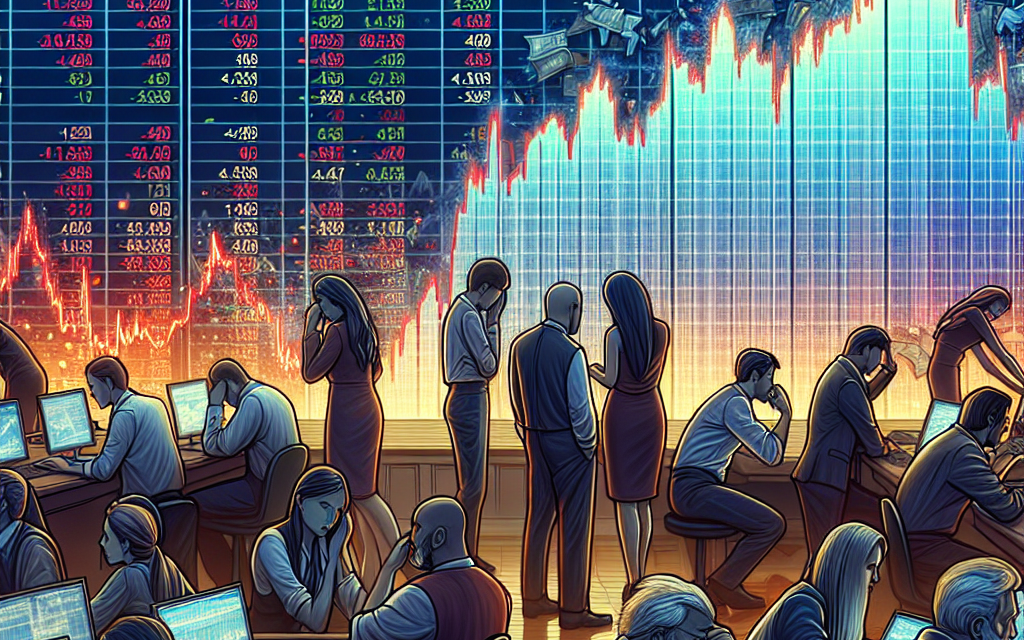“Markets Pause: Stocks Show Signs of Exhaustion After Rally Surge”
Introduction
Global stock markets showed signs of fatigue following a recent rally, as investors grappled with mixed economic signals and geopolitical uncertainties. After a period of robust gains driven by optimism over economic recovery and corporate earnings, major indices appeared to stall, reflecting a cautious sentiment among traders. Concerns over inflationary pressures, central bank policy shifts, and ongoing supply chain disruptions have contributed to a more subdued market environment. As investors reassess their strategies, the focus has shifted to upcoming economic data releases and policy announcements that could provide further direction. This market pause highlights the delicate balance between growth prospects and underlying risks, underscoring the complexity of navigating the current financial landscape.
Market Trends: Analyzing Stock Fatigue After Recent Rally
In recent weeks, the stock markets have exhibited signs of fatigue following a robust rally that invigorated investor sentiment. This phenomenon, often observed after a period of sustained upward momentum, suggests that the markets may be entering a phase of consolidation. As investors assess the sustainability of recent gains, several factors contribute to this emerging trend of market fatigue.
To begin with, the rally was largely driven by a combination of strong corporate earnings reports and optimism surrounding economic recovery. Companies across various sectors reported better-than-expected earnings, which bolstered confidence in the resilience of the economy. However, as the earnings season winds down, the initial excitement has begun to wane, leaving investors to ponder the next catalysts for growth. Without fresh drivers, the market’s upward trajectory appears to be losing steam.
Moreover, macroeconomic indicators have started to paint a mixed picture, adding to the uncertainty. While some data points, such as employment figures and consumer spending, continue to show strength, others, like inflation rates and supply chain disruptions, raise concerns. The persistence of inflationary pressures, in particular, has prompted speculation about potential interest rate hikes by central banks. Such monetary policy adjustments could dampen market enthusiasm, as higher borrowing costs may weigh on corporate profits and consumer spending.
In addition to these economic factors, geopolitical tensions have also played a role in tempering market exuberance. Ongoing conflicts and diplomatic standoffs in various regions have introduced an element of unpredictability, causing investors to adopt a more cautious stance. The potential for these tensions to escalate further adds a layer of risk that market participants must navigate, contributing to the overall sense of fatigue.
Furthermore, technical indicators suggest that the markets may be overextended. After a prolonged rally, stock valuations have reached levels that some analysts consider unsustainable. This has led to increased volatility, as investors reassess their positions and take profits. The resulting fluctuations in stock prices can create an environment of uncertainty, prompting market participants to exercise greater caution.
Despite these challenges, it is important to note that market fatigue does not necessarily signal an impending downturn. Instead, it may represent a natural pause, allowing investors to digest recent gains and recalibrate their strategies. During this period of consolidation, market participants may seek out opportunities in undervalued sectors or explore alternative asset classes to diversify their portfolios.
In conclusion, the current signs of market fatigue following the recent rally can be attributed to a confluence of factors, including the waning impact of strong earnings, mixed macroeconomic data, geopolitical uncertainties, and technical considerations. While these elements contribute to a more cautious market environment, they also present opportunities for strategic repositioning. As investors navigate this phase, maintaining a balanced perspective and staying informed about evolving market dynamics will be crucial. By doing so, they can better position themselves to capitalize on potential opportunities that may arise as the markets continue to evolve.
Investor Sentiment: Understanding Market Reactions to Stock Fatigue
Investor sentiment plays a crucial role in shaping market dynamics, particularly during periods of stock fatigue following a rally. Understanding how investors react to such fatigue is essential for comprehending broader market trends. After a sustained rally, markets often exhibit signs of exhaustion, as evidenced by fluctuating stock prices and reduced trading volumes. This phenomenon, commonly referred to as stock fatigue, can be attributed to several factors, including profit-taking, valuation concerns, and macroeconomic uncertainties.
Initially, during a rally, investor optimism tends to drive stock prices upward, fueled by positive economic indicators, strong corporate earnings, or favorable geopolitical developments. However, as the rally progresses, stocks may become overvalued, prompting investors to reassess their positions. This reassessment often leads to profit-taking, where investors sell off their holdings to lock in gains. Consequently, the influx of sell orders can exert downward pressure on stock prices, signaling the onset of fatigue.
Moreover, valuation concerns frequently accompany stock fatigue. As prices rise, the price-to-earnings ratios of stocks may reach levels that are unsustainable in the long term. Investors, wary of overpaying for assets, may become more cautious, leading to a slowdown in buying activity. This caution is further exacerbated by macroeconomic uncertainties, such as changes in interest rates, inflationary pressures, or geopolitical tensions, which can create an environment of unpredictability. In such scenarios, investors may adopt a wait-and-see approach, contributing to reduced market momentum.
Transitioning from the causes of stock fatigue to its implications, it is important to consider how investor sentiment influences market reactions. When fatigue sets in, market participants often exhibit heightened sensitivity to news and events. For instance, negative economic data or disappointing corporate earnings reports can trigger sharper-than-expected declines in stock prices. Conversely, positive developments may not elicit the same level of enthusiasm as they would during a rally, as investors remain cautious and skeptical.
Furthermore, stock fatigue can lead to increased market volatility. As investors grapple with uncertainty, their trading behavior may become more erratic, resulting in larger price swings. This volatility can be unsettling for both individual and institutional investors, prompting them to adjust their portfolios to mitigate risk. Consequently, sectors that were previously favored during the rally may experience a rotation, with investors reallocating their capital to more defensive or undervalued assets.
In addition to influencing market behavior, stock fatigue can also impact investor sentiment on a psychological level. The transition from a rally to a fatigued market can evoke feelings of anxiety and doubt among investors, particularly those who entered the market during the upswing. The fear of missing out, which often drives participation in rallies, may give way to concerns about potential losses. This shift in sentiment can lead to a more cautious investment approach, with investors prioritizing capital preservation over aggressive growth strategies.
In conclusion, understanding investor sentiment in the context of stock fatigue is essential for navigating market reactions effectively. As markets transition from a rally to a state of fatigue, factors such as profit-taking, valuation concerns, and macroeconomic uncertainties come into play, influencing investor behavior and market dynamics. By recognizing these patterns and their implications, investors can make informed decisions, balancing risk and opportunity in an ever-evolving financial landscape.
Economic Indicators: How They Influence Stock Market Fatigue
In the ever-evolving landscape of global finance, economic indicators serve as crucial barometers, providing insights into the health and direction of economies. These indicators, ranging from employment figures to consumer confidence indices, play a pivotal role in shaping investor sentiment and, consequently, stock market performance. Recently, the stock market has shown signs of fatigue following a robust rally, prompting analysts to delve deeper into the underlying economic indicators that may be influencing this trend.
To begin with, one of the primary economic indicators impacting market sentiment is the employment data. A strong labor market typically signals economic growth, encouraging investors to remain optimistic about future corporate earnings. However, when employment figures plateau or decline, it can lead to concerns about economic stagnation, prompting investors to reassess their positions. In recent months, while employment numbers have remained relatively stable, there has been a noticeable slowdown in job creation, which may be contributing to the current market fatigue.
Moreover, inflation rates are another critical factor that investors closely monitor. Rising inflation can erode purchasing power and squeeze profit margins, leading to a more cautious approach in the stock market. Central banks often respond to inflationary pressures by adjusting interest rates, which can further influence market dynamics. In the current economic climate, inflation has been a persistent concern, with central banks around the world grappling with the challenge of balancing growth and price stability. This uncertainty surrounding inflation and monetary policy decisions may be adding to the sense of fatigue in the stock market.
In addition to employment and inflation, consumer confidence is a vital indicator of economic health. High levels of consumer confidence typically translate into increased spending, driving corporate revenues and, by extension, stock prices. However, recent surveys have indicated a dip in consumer confidence, possibly due to geopolitical tensions and economic uncertainties. This decline in consumer sentiment can lead to reduced spending, thereby dampening corporate earnings prospects and contributing to the observed market fatigue.
Furthermore, global trade dynamics also play a significant role in shaping market sentiment. Trade tensions, tariffs, and supply chain disruptions can have far-reaching effects on economic growth and corporate profitability. In recent times, geopolitical developments have introduced a layer of complexity to global trade, with potential implications for market stability. Investors, wary of these uncertainties, may adopt a more cautious stance, leading to a slowdown in market momentum.
Transitioning to corporate earnings, it is essential to recognize their influence on stock market performance. While many companies have reported strong earnings in recent quarters, there is growing concern about the sustainability of these results in the face of economic headwinds. As companies navigate challenges such as rising input costs and supply chain constraints, investors may question the ability of firms to maintain their growth trajectories, thereby contributing to market fatigue.
In conclusion, the interplay of various economic indicators, including employment data, inflation rates, consumer confidence, global trade dynamics, and corporate earnings, significantly influences stock market sentiment. As these indicators fluctuate, they can create an environment of uncertainty, leading to periods of market fatigue following rallies. Investors, therefore, must remain vigilant, continuously assessing these indicators to make informed decisions in an ever-changing economic landscape. By understanding the intricate connections between these factors, market participants can better navigate the complexities of the financial markets and anticipate potential shifts in market dynamics.
Sector Performance: Identifying Winners and Losers Amid Market Fatigue

In the wake of a robust rally, the stock markets are showing signs of fatigue, prompting investors to reassess sector performance to identify both winners and losers. This period of market fatigue, characterized by a slowdown in momentum, has led to a more cautious approach among market participants. As investors navigate this complex landscape, understanding the dynamics within various sectors becomes crucial for making informed decisions.
The technology sector, which has been a significant driver of the recent rally, is now experiencing a deceleration in its upward trajectory. While tech stocks have enjoyed substantial gains due to strong earnings reports and continued innovation, the sector is now facing headwinds. Concerns over high valuations and potential regulatory challenges are causing investors to adopt a more conservative stance. Despite these challenges, certain tech companies with robust fundamentals and diversified revenue streams continue to perform well, highlighting the importance of selectivity within the sector.
Conversely, the energy sector has emerged as a notable winner amid market fatigue. Rising oil prices, driven by supply constraints and geopolitical tensions, have bolstered the performance of energy stocks. Companies involved in oil exploration and production have seen their stock prices rise, benefiting from increased demand and higher profit margins. Additionally, the transition towards renewable energy sources has provided opportunities for companies specializing in clean energy technologies. This dual dynamic within the energy sector underscores the importance of adaptability and innovation in navigating market shifts.
Meanwhile, the consumer discretionary sector is experiencing mixed results. On one hand, companies in the travel and leisure industry are witnessing a resurgence in demand as pandemic-related restrictions ease. This has led to improved performance for airlines, hotels, and entertainment companies. On the other hand, retailers are grappling with supply chain disruptions and rising costs, which are impacting their profit margins. As a result, investors are closely monitoring consumer spending patterns and inflationary pressures to gauge the sector’s future trajectory.
In the financial sector, banks and financial institutions are benefiting from rising interest rates, which have improved their net interest margins. This has led to increased profitability for many banks, making the financial sector a relative winner in the current market environment. However, concerns over potential loan defaults and economic uncertainty continue to pose risks. As such, investors are focusing on banks with strong balance sheets and prudent risk management practices.
The healthcare sector, traditionally seen as a defensive play, is also experiencing varied performance. Pharmaceutical companies with successful drug pipelines and those involved in COVID-19 vaccine production have performed well. However, the sector faces challenges related to drug pricing pressures and regulatory scrutiny. Investors are therefore prioritizing companies with innovative therapies and strong research and development capabilities.
In conclusion, as the stock markets exhibit signs of fatigue following a significant rally, sector performance has become a focal point for investors seeking to identify winners and losers. The technology sector faces valuation concerns, while the energy sector benefits from rising oil prices and the shift towards renewables. The consumer discretionary sector presents a mixed picture, with travel-related companies rebounding and retailers facing challenges. Financial institutions gain from higher interest rates, yet remain cautious of economic uncertainties. Lastly, the healthcare sector’s performance is influenced by innovation and regulatory factors. By closely analyzing these sector dynamics, investors can better navigate the complexities of a fatigued market and make informed investment decisions.
Trading Strategies: Navigating Stock Market Fatigue
In the ever-evolving landscape of financial markets, traders and investors are constantly seeking strategies to navigate the complexities of stock market behavior. Recently, the markets have shown signs of fatigue following a significant rally, prompting market participants to reassess their trading strategies. Understanding the underlying factors contributing to this fatigue and adapting accordingly is crucial for those looking to maintain a competitive edge.
To begin with, it is essential to recognize that market fatigue often follows periods of exuberant growth. During a rally, stocks experience substantial gains, driven by positive economic indicators, strong corporate earnings, or favorable geopolitical developments. However, as the rally progresses, the initial momentum can wane, leading to a period of consolidation or even a pullback. This fatigue is not uncommon and can be attributed to several factors, including profit-taking by investors, overvaluation concerns, or external economic pressures.
In light of these dynamics, traders must adopt a more cautious approach. One effective strategy is to focus on diversification. By spreading investments across various sectors and asset classes, traders can mitigate the risks associated with market fatigue. Diversification not only helps in reducing exposure to any single stock or sector but also provides a buffer against market volatility. Moreover, it allows traders to capitalize on opportunities in sectors that may be less affected by the prevailing fatigue.
Another strategy to consider is the implementation of technical analysis. By examining historical price patterns and trading volumes, traders can identify potential support and resistance levels. These insights can be invaluable in determining entry and exit points, especially during periods of market fatigue. Technical indicators such as moving averages, relative strength index (RSI), and Bollinger Bands can provide additional guidance, helping traders make informed decisions based on market trends rather than emotions.
Furthermore, it is important to remain vigilant about macroeconomic indicators. Economic data releases, central bank policies, and geopolitical events can significantly impact market sentiment. Staying informed about these developments allows traders to anticipate potential market shifts and adjust their strategies accordingly. For instance, if economic data suggests a slowdown, traders might consider shifting their focus to defensive stocks or sectors that tend to perform well during economic downturns.
In addition to these strategies, maintaining a disciplined approach to risk management is paramount. Setting stop-loss orders and adhering to predetermined risk-reward ratios can help protect against significant losses during periods of market fatigue. By establishing clear risk parameters, traders can ensure that their portfolios remain resilient, even in the face of unexpected market movements.
Lastly, it is crucial to maintain a long-term perspective. While market fatigue may present short-term challenges, it is important to remember that markets are inherently cyclical. Periods of consolidation or pullbacks are often followed by renewed growth, driven by underlying economic fundamentals. By keeping a focus on long-term goals and maintaining a well-balanced portfolio, traders can weather the storm of market fatigue and position themselves for future opportunities.
In conclusion, navigating stock market fatigue requires a combination of strategic planning, technical analysis, and disciplined risk management. By diversifying portfolios, staying informed about macroeconomic trends, and maintaining a long-term perspective, traders can effectively manage the challenges posed by market fatigue. As the markets continue to evolve, these strategies will remain essential tools for those seeking to thrive in the dynamic world of trading.
Global Markets: Comparing Stock Fatigue Across Different Regions
In recent weeks, global stock markets have exhibited signs of fatigue following a period of robust rallies. This phenomenon, observed across various regions, underscores the complex interplay of factors influencing investor sentiment and market dynamics. As we delve into the intricacies of this trend, it becomes evident that while the overarching theme of fatigue is consistent, the underlying causes and manifestations differ across regions.
In the United States, the stock market’s recent lethargy can be attributed to a confluence of factors. After a strong rally driven by optimism surrounding economic recovery and corporate earnings, investors are now grappling with concerns over inflationary pressures and potential interest rate hikes by the Federal Reserve. These apprehensions have led to increased volatility, as market participants weigh the implications of monetary policy adjustments on future growth prospects. Moreover, geopolitical tensions and supply chain disruptions have further compounded the uncertainty, prompting a more cautious approach among investors.
Transitioning to Europe, the situation presents a slightly different narrative. While European markets have also experienced a slowdown, the fatigue here is more closely linked to the region’s uneven economic recovery. The resurgence of COVID-19 cases in certain countries has raised questions about the sustainability of growth, leading to a more subdued market environment. Additionally, the European Central Bank’s cautious stance on monetary policy has contributed to a sense of ambivalence among investors, who are seeking clearer signals regarding the future trajectory of interest rates and economic support measures.
In Asia, the picture is equally nuanced. Chinese markets, for instance, have been weighed down by regulatory crackdowns on key sectors such as technology and real estate. These interventions have sparked concerns about the broader implications for economic growth and corporate profitability, leading to a more restrained market performance. Meanwhile, in Japan, the stock market’s fatigue can be linked to a combination of domestic and external factors. The country’s ongoing battle with COVID-19, coupled with supply chain challenges and a relatively slow vaccine rollout, has dampened investor enthusiasm. Furthermore, Japan’s heavy reliance on exports makes it particularly vulnerable to global economic shifts, adding another layer of complexity to the market’s outlook.
Despite these regional variations, a common thread running through global markets is the heightened focus on sustainability and environmental, social, and governance (ESG) considerations. Investors are increasingly factoring in ESG criteria when making investment decisions, reflecting a broader shift towards responsible investing. This trend, while promising in terms of fostering long-term value creation, also introduces new challenges as companies and markets adapt to evolving expectations.
In conclusion, the current fatigue observed in global stock markets is a multifaceted phenomenon shaped by a diverse array of regional and global factors. While the initial rally was fueled by optimism and recovery hopes, the subsequent slowdown highlights the complexities and uncertainties that continue to influence market behavior. As investors navigate this landscape, they must remain vigilant and adaptable, balancing short-term risks with long-term opportunities. By understanding the unique dynamics at play in different regions, market participants can better position themselves to respond to the challenges and opportunities that lie ahead.
Future Outlook: Predicting Market Movements Post-Stock Fatigue
In the wake of a robust rally, the stock markets are now exhibiting signs of fatigue, prompting investors and analysts to ponder the future trajectory of market movements. This period of fatigue, characterized by a slowdown in momentum and a potential plateau in stock prices, raises questions about the sustainability of recent gains and the factors that could influence future market behavior. As we delve into the future outlook, it is essential to consider both macroeconomic indicators and market sentiment, which together play a crucial role in shaping investor expectations and decision-making.
To begin with, the global economic landscape remains a pivotal factor in predicting market movements. Recent economic data, including employment figures, inflation rates, and GDP growth, provide valuable insights into the health of the economy. For instance, a strong labor market and rising consumer spending can bolster investor confidence, potentially offsetting the effects of market fatigue. Conversely, persistent inflationary pressures or geopolitical tensions could exacerbate market volatility, leading to a more cautious approach among investors.
Moreover, central bank policies continue to be a significant driver of market sentiment. In recent months, central banks around the world have been navigating the delicate balance between supporting economic growth and curbing inflation. Interest rate decisions, in particular, are closely watched by market participants, as they influence borrowing costs and, consequently, corporate profitability. A hawkish stance by central banks, signaling tighter monetary policy, could dampen investor enthusiasm and contribute to market fatigue. On the other hand, a dovish approach, indicating continued support for economic recovery, might provide a much-needed boost to market sentiment.
In addition to macroeconomic factors, corporate earnings reports offer critical insights into the future direction of stock markets. As companies release their quarterly results, investors scrutinize revenue growth, profit margins, and forward guidance to assess the overall health of the corporate sector. Strong earnings performance can serve as a catalyst for renewed market optimism, while disappointing results may reinforce the prevailing sense of fatigue. Furthermore, sector-specific trends, such as advancements in technology or shifts in consumer preferences, can also influence market dynamics, creating opportunities for growth in certain industries even amid broader market fatigue.
Another aspect to consider is the role of investor psychology and behavioral finance in shaping market movements. Market fatigue often leads to increased caution among investors, who may become more risk-averse and seek safer assets. This shift in sentiment can result in a rotation from high-growth stocks to more stable, dividend-paying equities or fixed-income securities. Understanding these behavioral patterns is crucial for predicting market trends, as they can amplify or mitigate the impact of economic and corporate fundamentals.
Finally, it is important to acknowledge the potential for unforeseen events, or “black swan” occurrences, which can disrupt market expectations and lead to sudden shifts in investor sentiment. While these events are inherently unpredictable, their impact on markets can be profound, underscoring the need for a diversified investment strategy that can withstand periods of uncertainty.
In conclusion, as the stock markets exhibit signs of fatigue following a rally, the future outlook hinges on a complex interplay of macroeconomic indicators, central bank policies, corporate earnings, and investor psychology. By closely monitoring these factors and remaining adaptable to changing conditions, investors can better navigate the challenges and opportunities that lie ahead in the post-fatigue market environment.
Q&A
1. **Question:** What is the main theme of the “Markets Wrap: Stocks Indicate Fatigue Following Rally” article?
**Answer:** The main theme is that stock markets are showing signs of exhaustion or fatigue after experiencing a significant rally.
2. **Question:** What factors are contributing to the fatigue in the stock markets?
**Answer:** Contributing factors may include profit-taking by investors, economic data releases, geopolitical tensions, or central bank policy signals.
3. **Question:** How are major stock indices performing according to the article?
**Answer:** Major stock indices are likely experiencing slight declines or stagnation, indicating a pause or pullback after recent gains.
4. **Question:** What sectors or stocks are most affected by the market fatigue?
**Answer:** Typically, high-growth sectors or stocks that led the rally might be most affected, such as technology or consumer discretionary sectors.
5. **Question:** Are there any specific economic indicators mentioned that are influencing market sentiment?
**Answer:** Economic indicators such as employment data, inflation rates, or GDP growth figures might be influencing market sentiment.
6. **Question:** What is the outlook for the stock market in the near term according to the article?
**Answer:** The outlook might be cautious or uncertain, with potential for volatility as investors assess economic conditions and corporate earnings.
7. **Question:** Are there any strategies suggested for investors in light of the market fatigue?
**Answer:** Strategies might include diversifying portfolios, focusing on defensive stocks, or maintaining a long-term investment perspective.
Conclusion
The recent market activity suggests that stocks are showing signs of fatigue after a period of rallying. This could indicate that investors are becoming cautious, possibly due to concerns about overvaluation, economic uncertainties, or upcoming financial data releases. The fatigue in the market may lead to increased volatility or a potential pullback as investors reassess their positions and market conditions.





